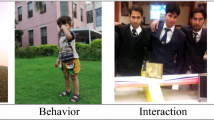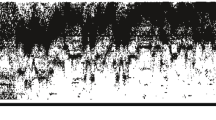Abstract
The analysis of lectures and meetings inside smart rooms has recently attracted much interest in the literature, being the focus of international projects and technology evaluations. A key enabler for progress in this area is the availability of appropriate multimodal and multi-sensory corpora, annotated with rich human activity information during lectures and meetings. This paper is devoted to exactly such a corpus, developed in the framework of the European project CHIL, “Computers in the Human Interaction Loop”. The resulting data set has the potential to drastically advance the state-of-the-art, by providing numerous synchronized audio and video streams of real lectures and meetings, captured in multiple recording sites over the past 4 years. It particularly overcomes typical shortcomings of other existing databases that may contain limited sensory or monomodal data, exhibit constrained human behavior and interaction patterns, or lack data variability. The CHIL corpus is accompanied by rich manual annotations of both its audio and visual modalities. These provide a detailed multi-channel verbatim orthographic transcription that includes speaker turns and identities, acoustic condition information, and named entities, as well as video labels in multiple camera views that provide multi-person 3D head and 2D facial feature location information. Over the past 3 years, the corpus has been crucial to the evaluation of a multitude of audiovisual perception technologies for human activity analysis in lecture and meeting scenarios, demonstrating its utility during internal evaluations of the CHIL consortium, as well as at the recent international CLEAR and Rich Transcription evaluations. The CHIL corpus is publicly available to the research community.





Similar content being viewed by others
References
AMI—Augmented Multiparty Interaction. http://www.amiproject.org
Burger, S., McLaren, V., & Yu, H. (2002). The ISL meeting corpus: The impact on meeting type on speech style. In Proceedings of International Conference on Spoken Language Processing, Denver, USA.
CALO—Cognitive Agent that Learns and Organizes. http://www.caloproject.sri.com/
CHIL—Computers in the Human Interaction Loop. http://www.chil.server.de
Classification of Events, Activities, and Relationships Evaluation and Workshop. http://www.clear-evaluation.org
ELRA Catalogue of Language Resources. http://www.catalog.elra.info
Janin, A., Baron, D., Edwards, J., Ellis, D., Gelbart, D., Morgan, N., Peskin, B., Pfau, T., Shriberg, E., Stolcke, A., & Wooters, C. (2003). The ICSI meeting corpus. In Proceedings of International Conference on Acoustics, Speech, and Signal Processing (ICASSP), Hong Kong, China.
Mostefa, D., et al. (2005). Chil Public Deliverable D7.6: Exploitation material for CHIL evaluation campaign 1. http://www.chil.server.de/servlet/is/8063/
Mostefa, D., Garcia, M.-N., & Choukri, K. (2006). Evaluation of multimodal components within CHIL. In Proceedings of the 5th International Language Resources and Evaluations Conference (LREC), Genoa, Italy.
Stiefelhagen, R., Bernardin, K., Bowers, R., Garofolo, J., Mostefa, D., & Soundararajan, P. (2007). The CLEAR 2006 evaluation. In R. Stiefelhagen & J. Garofolo (Eds.), Multimodal Technologies for Perception of Humans. Proceedings of the First International CLEAR Evaluation Workshop, CLEAR 2006, number 4122 in Springer Lecture Notes in Computer Science, pp. 1–45.
Stiefelhagen, R., & Garofolo, J. (Eds). (2007). Multimodal Technologies for Perception of Humans, First International Evaluation Workshop on Classification of Events, Activities and Relationships, CLEAR’06. Number 4122 in Lecture Notes in Computer Science, Springer.
The AGTK Annotation Tool. http://www.agtk.sourceforge.net
The CLEF Website. http://www.clef-campaign.org/
The NIST MarkIII Microphone Array. http://www.nist.gov/smartspace/cmaiii.html
The NIST Smart Space Project. http://www.nist.gov/smartspace/
The Rich Transcription 2006 Spring Meeting Recognition Evaluation Website. http://www.nist.gov/speech/tests/rt/rt2006/spring
The Transcriber Tool Home Page. http://www.trans.sourceforge.net
VACE—Video Analysis and Content Extraction. https://www.control.nist.gov/dto/twiki/bin/view/Main/WebHome
Acknowledgments
The work presented here was partly funded by the European Union under the integrated project CHIL, “Computers in the Human Interaction Loop” (Grant Number IST-506909).
Author information
Authors and Affiliations
Corresponding author
Additional information
Ambrish Tyagi has contributed to this work during two summer internships with the IBM T.J. Watson Research Center.
Rights and permissions
About this article
Cite this article
Mostefa, D., Moreau, N., Choukri, K. et al. The CHIL audiovisual corpus for lecture and meeting analysis inside smart rooms. Lang Resources & Evaluation 41, 389–407 (2007). https://doi.org/10.1007/s10579-007-9054-4
Received:
Accepted:
Published:
Issue Date:
DOI: https://doi.org/10.1007/s10579-007-9054-4




